Good Quality Video, Nice Form Factor
The new Replay XD1080 video camera captures excellent quality HD video.
It’s beautifully constructed with an anodized aluminum body and the kit comes with a nice selection of accessories.
The camera control system uses a clever design that’s easy to use and the camera has a few nice features that are very useful for taking video while riding a motorcycle.
It usually takes a version or two before a manufacturer gets a new camera design just right. Sometimes it never happens, no matter how hard they try.
The designers of the new Replay XD1080 video camera did their homework, however, and came up with an excellent design with unique features that are perfect for motorcycle use.
The camera is not cheap, with a $300.00 list price, but it’s not out of line with the normally high price of a motorcycle video camera.
And so far I’d have to say it’s one of the most useful and usable motorcycle video cameras currently available, which goes a long way towards justifying the cost.
The video quality is excellent — nearly the equal of the GoPro HD (review), which is the current champ (just barely) in that department.
The Replay XD1080’s size, shape, usability factor and even the way it operates has the GoPro beat hands down though.
If the Replay XD1080 can do all this with its tiny form factor, then why do others struggle?
It captures HD video at 1080p at 30 FPS (frames per second); 720p at 30 or 60 FPS; still photos at various intervals and it even has live HDMI video streaming, all controlled with just two buttons that display a series of tiny colored LED lights.
It’s so easy, you don’t even need the thin little owner’s manual that comes with the camera.
There’s a cheat sheet printed inside the rear cover that screws on to the back of the Replay XD1080. Just don’t lose that cover though…
The very solid, hard anodized aluminum tube body is not only rugged, it has a pair of buttons that — hallelujah! — you can actually feel when wearing motorcycle gloves.
And the Replay XD1080 has one more trick up its sleeve — haptic feedback when you press the buttons!
The camera beeps and vibrates to let you know what it’s doing, and you can feel the vibration through most motorcycle helmets, at least if you’re not moving too fast, where wind buffeting overwhelms the vibes.
You have to hand it to the Replay designers — they really thought about how a video camera gets used in the real world. I’d bet more than one of them owns a motorcycle!
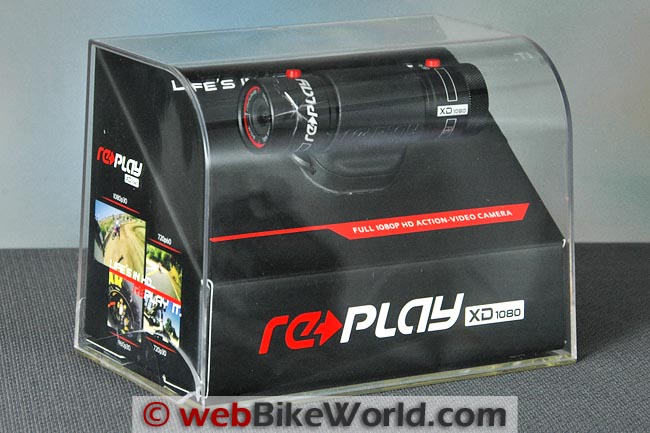
Where to Buy Replay XD1080 Video Camera
Check Reviews & Prices on AmazonSee More: Motorcycle Accessories, Motorcycle Tire, Motorcycle Helmets
Replay XD1080 Features
The Replay XD1080 is claimed to be the “smallest and lightest full HD action-camera on the market” and I have no reason to doubt it.
The aluminum “hard anodized” body is “water resistant” and measures just 94 mm long by 28 mm in diameter and the camera body weighs 87 grams.
The Replay XD1080 captures 1080p video at 30 FPS and it also takes 960p or 720p, the latter at 30 or 60 FPS.
60 FPS doesn’t look much different than 30 FPS unless the video is run in slow motion, and then the 60 FPS version, with more frames per second, appears smoother. The files are saved in H.264 .MOV format.
The camera will also take still photos at 3, 5, 15 or 30 second intervals and we made a quick stop-motion video comparing the Replay XD1080 and the Drift HD (see below).
The business end is covered with a screw-on protective clear lens cover, another nice feature because neither the Drift X170 video camera (review), the Drift HD170 (review) have a lens cover, and their protruding “fish eye” lenses can be easily scratched.
The GoPro HD (review) camera also has a “fish eye” lens, so the camera has to be placed inside a big plastic housing, which gives it a lot of bulk and makes it clumsy for motorcycle use — especially when you try to mount it on a helmet.
The Replay XD1080 web page is a bit confusing because it appears to indicate that the user can adjust the contrast, sharpness, saturation and audio gain.
But I think what they meant to say was that those features are automatically adjusted by the camera’s software, because I can find no way to do it manually, nor are these adjustments referenced in the owner’s manual.
The camera has a built-in HDMI port and it even comes with an HDMI cable, which can be used to get a live view of sorts, if you feel like carrying a laptop with you.
I suppose the HDMI cable might be used to connect to a tablet type computer or other device but I haven’t tried it.
There’s a cryptic note in the Replay XD1080 marketing material that reads “External display option (available late 2011) iPad with iOS4 or higher” and “Android Compatible (Select Devices)”. Not sure that that will amount to either…
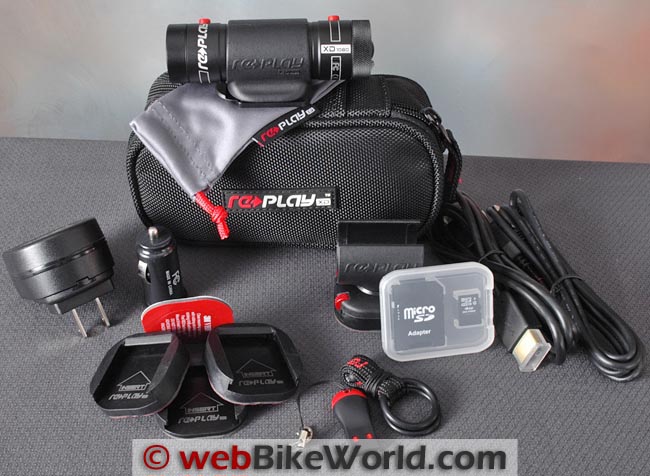
In the Box
The Replay XD1080 comes with — hurray! — a nice soft carrying case that includes a zipper and belt hook. We’ve complained about the reluctance of video camera manufacturers to provide a carrying case before.
Most of these cameras come in useless display boxes that only add to the waste stream, instead of a container that could serve double-duty as a carrying case.
The Replay XD1080 still comes in a useless clear plastic case that was cracked in several places when we received it, but at least the soft camera case they give you can be used to carry the camera and the accessories.
You’re on your own with the Drift or GoPro cameras…
The camera has a built-in rechargeable Lithium-Ion battery.
It’s not replaceable, a victim of the small form factor.
It’s rated at 3.7 V and 750 mAh. Battery life is a bit of a problem with the Replay XD1080; it’s rated at 122 minutes of video but ours shows only about 1/4 full after taking only about 20 minutes of video at full resolution.
It’s very difficult to estimate the exact battery life of a video camera because it’s not on and recording the entire time. Cameras are turned on and off, recording is started and stopped, which varies the battery life.
The Replay XD1080 comes with a 4GB microSD card and an SD card adapter.
The microSD card slot is located under the screw-on rear cap, which has a very fine thread, so care must be taken to ensure that the cap doesn’t get cross-threaded on the camera body.
The cap has a hole for a lanyard and the camera comes with a looped lanyard that I haven’t been able to figure out how to use.
I don’t want it flying around when the camera is mounted on the helmet anyway, so I’ll just have to be careful about not losing the cap.
Also located under the cap are the HDMI port, a mini-USB port for recharging or downloading the video files (or you can pop out the microSD card and place it in the included adapter and put it in an SD card reader), and two buttons for controlling the camera.
Replay also includes a neat little camera mount that’s nearly perfect for motorcycle helmet use.
More on this in the “Mounting the Replay XD1080” section below.
With its small size, solid construction and light weight, the Replay XD1080 is a breeze to mount on a motorcycle helmet or the motorcycle (remember, “smaller is better”).
The camera has a 135-degree field of view, which is narrower than the 170-degree lens on the Drift cameras, but there is no visible barrel distortion or “fish eye” effect with the Replay XD1080 — a good thing by any measure.
And you really don’t notice those missing degrees anyway, as you can see in our comparison video below, which compares the GoPro HD, Drift HD170, Drift HD and Replay XD1080 video cameras.
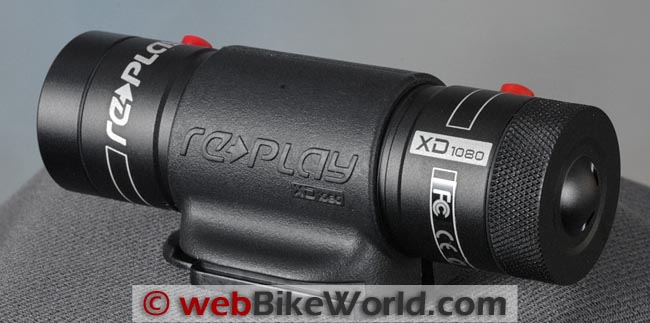
Ease of Use
Despite the potential for confusion, what with the tiny buttons inside the rear cover, the Replay XD1080 is a breeze to use.
Take a quick run through the slim owner’s manual and once you get the hang of it, you’ll probably agree that it’s a very clever design.
Press and hold the front button for about 4 seconds and the camera will vibrates 3 times to let you know it’s now on. Press the rear button once to start the video and the camera vibrates 3 times.
Press it again to save the video and start another, and the camera vibrates to let you know “message received”.
Press and hold the front button to turn the camera off, although it will not turn off if a video is being recorded — a safety feature. You have to stop the video recording first.
Blue and red LED lights next to the buttons also let you know when the camera is on or recording.
Any of the video or still photo modes can be easily selected by pressing the two buttons located under the rear cover.
One button selects the modes and the other selects either the video resolution or photo intervals. That’s all there is to it.
The LED lights have different colors, but they indicate the modes and the cheat sheet inside the rear cover helps.
The owner’s manual has a page that uses only about 15% of the space to show the LED color chart. It’s so tiny that the colors can’t be isolated from one another to see what they’re telling you; they should have used an entire page to illustrate this.
Fortunately, it’s easy enough to understand how the buttons actually work once you start playing with them. And they cycle back to the beginning settings again (1080p video at 30 FPS), so you can’t get lost.
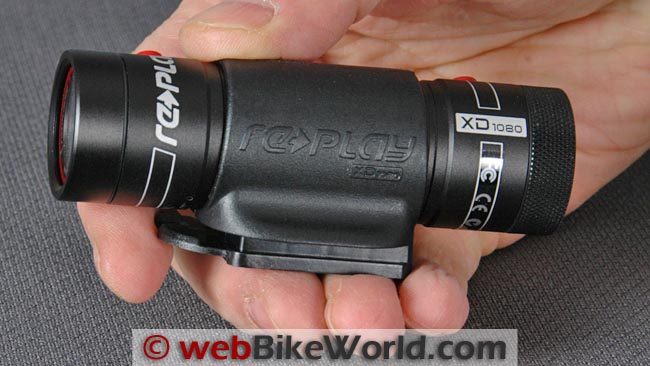
Where to Buy Replay XD1080 Video Camera
Check Reviews & Prices on AmazonSee More: Motorcycle Accessories, Motorcycle Tire, Motorcycle Helmets
Mounting the Replay XD1080
Mounting the Replay XD1080 is also relatively easy, compared to most motorcycle video cameras. So far, I’ve used only the rotating mount mentioned in the previous section, because it’s all I’ve needed.
It’s a low-profile device that fits on a motorcycle helmet better than any other motorcycle video camera we’ve reviewed, bar none.
The only trick is getting the lens oriented so that you’ll record the video you expect.
It seems to be a little more difficult than usual to get the Replay XD1080 oriented correctly on a motorcycle helmet — it took me four tries to get it right.
The owner’s manual hints that you really need to set the camera so it’s tilted back when mounted on top of the helmet, because a helmet naturally tilts much farther forward than you think. They’re right.
The first time out, I ended up recording the instrument panel. Next time I had a video of the front wheel; after that it was the road about 2 meters in front of the bike.
I finally ended up mounting the camera much farther back on the helmet and ended up with the results in the video below. Perhaps the smaller 135-degree field of view makes the difference in mounting compared to the 170-degree Drift cameras.
A good way to see if you have it mounted correctly is to put on a helmet and buckle up, just like you’re going for a ride. Sit on the bike and then place the Replay XD1080 on its mount on top of the helmet.
Have a friend look at it from the side and make sure the lens is perpendicular to the ground and pointing forward, then make a pencil mark or use a piece of tape to mark where the mount should go.
I bet you’ll find it’s much farther back and tilted higher than you anticipated.
While you’re at it, take 10 seconds of video and play it on your computer, just to make sure you have everything lined up correctly. If I would have done this the first time, I would have avoided a lot of frustration.
By the way, you can buy gaffer’s tape or 3M No-Residue Duct Tape (which is less expensive), which is what I use to make sure the camera and mount stay put on the helmet.
I don’t trust the double-sided sticky tape and I like to move the camera from one helmet to another anyway.
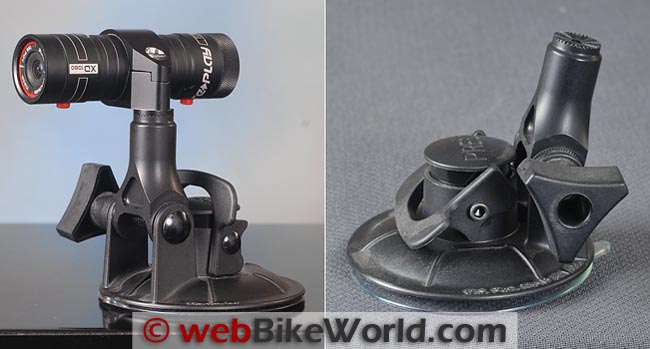
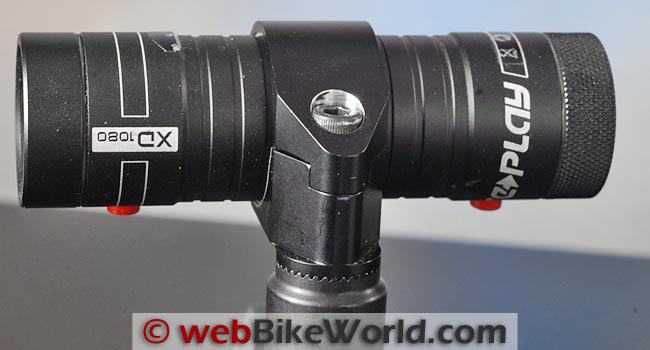
The Replay XD1080 Suction Cup Mount
The XD1080 slides into the mount provided with the camera (photo right, below) and it rotates through a shallow arc in two planes (see the video below).
I say “nearly perfect” because if only they made this mount with about a 15 mm tall extension on the ball mount, it would be perfect. As it is, there isn’t quite enough rotation angle; more movement would make it much better.
As is usually, Replay offers a host of accessories, including an external mic that connects to the HDMI port.
I purchased the special Replay XD 70-RPXD1080-PRO-CC Clamp ($40.00) and the special Replay XD Suction Cup Base Mount ($38.00) which is a version of the Delkin “Fat Gecko” suction cup mount (review), both of which are shown in the two photos above.
This two-part system is expensive, but it includes a nicely machined aluminum ring to hold the Replay XD1080, and the suction cup mount has a special head to attach the ring.
It works well and is the most solid mount we’ve found on any motorcycle video camera we have reviewed.
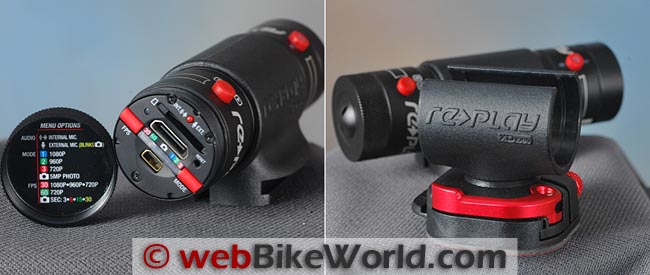
Video Types and Quality
The Replay XD1080 takes excellent quality video; we think it’s nearly the equal of the GoPro HD, the current champ when it comes to video quality, correct exposure and color rendition.
None of the motorcycle video cameras we have reviewed capture video as good as most common digital cameras, but then again, a digital camera doesn’t have to deal with the special form factor of a motorcycle video camera.
The Replay XD1080 does struggle a bit with exposure, especially if you are in the shadows and traveling into bright light or if there is bright light outside the shadows affecting the automatic exposure algorithm.
The camera will expose for the shadows and burn out the highlights, sometimes very dramatically. But that’s a criticism of all of the motorcycle video cameras we’ve reviewed.
Also, the colors tend towards oversaturation in the Replay XD1080; the GoPro HD actually has very natural color rendition, or better than any of the other motorcycle video cameras anyway.
Watch the comparison video below and you can see after the bike passes the red barn and goes out into the open, the clouds can be seen and are nicely exposed with the GoPro HD, better than any of the other cameras.
The 135-degree field of view of the Replay XD1080 also seems more natural and has very little barrel distortion.
All in all, the camera takes excellent quality video and this, combined with the very handy form factor, is quickly winning over converts here, making it a current favorite.
Where to Buy Replay XD1080 Video Camera
Check Reviews & Prices on AmazonSee More: Motorcycle Accessories, Motorcycle Tire, Motorcycle Helmets
Replay XD1080 Feature Demonstration and Video Samples
Here’s a video (below) that first runs through the features of the new Replay XD1080, then takes you on a tour of our favorite road for comparing motorcycle video cameras.
The weather has been on and off rain and clouds over the last several weeks, so the roads were mostly wet.
It was somewhat difficult to find consistent lighting conditions, although the sun finally broke through and another ride segment was added to the end of the video for comparison.
NOTE: The quality of the video as displayed on YouTube is lower than the quality of the original .MOV file as viewed on your computer.
The YouTube video below was first processed from the raw .MOV H.264 state and saved as a 1080p .mpeg in Photoshop Premiere Elements 10, then imported to YouTube, where it is compressed again.
Each time the video is processed, the quality usually degrades slightly. The original file is devoid of the artifacts visible in the YouTube video as the camera moves into the shadows.
Other Features of the Replay XD1080
The Replay XD1080 has an external microphone located along the bottom towards the front half of the camera body. It’s a tiny hole and, as is typical of a motorcycle video camera, it’s pretty much worthless over about 5 MPH or so.
They include a sheet with a half-dozen stickers on it in the kit; the stickers are supposed to be placed over the hole to help attenuate the noise but they don’t seem to help.
Replay offers an accessory HDMI external microphone, but you’d have to remove the rear cap to connect it to the HDMI port in the camera. I’m not sure if the external mic kit includes a separate cover with a port for the HDMI cable or not.
The camera is claimed “water resistant”.
The screw-on rear cover has an O-ring at the bottom of the threads on the camera body, as does the front lens cover. I can’t tell how the top buttons are protected but I’d have to assume they have some sort of water resistance.
The Replay XD1080 will accept microSD cards up to 32GB in size.
It comes with a 4GB microSD card and adapter. Replay doesn’t list a speed requirement for the memory card, but faster is usually better when it comes to video and I usually try to buy Class 8 or above cards to record video.
One thing you should always have with you when outdoors with a video camera is a high-quality Microfiber lens cleaning cloth to clear the bugs and grime off the lens, but do it carefully.
|
webBikeWorld Overall Opinionator: Replay XD1080 Video Camera
|
|
|---|---|
| Picks… | …and Pans |
|
|
Conclusion
The Replay XD1080 is a definite winner and, I think, my new favorite motorcycle video camera. It has jumped to the top of the heap in the now-crowded motorcycle video camera field with a super-solid aluminum construction and a high usability factor. And by the way — it takes excellent quality video also!
The camera is very small and the design makes it one of the most useful shapes for motorcycle use, whether it is mounted on either the helmet or the bike.
The protruding buttons on top and the vibrating haptic feedback are a real plus, which make the absence of a live view less important.
The price is a bit high but nearly $70.00 less than the Drift HD and you’re buying top-quality metal construction that feels like it can take a lot of abuse — a not-too-uncommon side effect of using a video camera on a motorcycle.
The bottom line is that the Replay XD1080 puts it all together in a package that is nearly perfect for motorcycle use.
More webBikeWorld:
▪ Video Action Camera Reviews
▪ Intercom and Radio Reviews
|
wBW Review: Replay XD1080 Video Camera
|
|
|---|---|
| Manufacturer: Replay XD | List Price: $299.99 USD. |
| Colors: Black. | Made In: China |
| Review Date: October 2011 | |
Where to Buy Replay XD1080 Video Camera
Check Reviews & Prices on AmazonSee More: Motorcycle Accessories, Motorcycle Tire, Motorcycle Helmets
Owner Comments and Feedback
See details on submitting comments.
From “R.M.” (October 2011): “I am glad to read that there is one more excellent Sportscam available at the market. I haven’t yet decided which one to buy, also as cost is somewhat of an issue, but the ReplayXD definitely is a good candidate.
Reading the test I came to the conclusion you have not yet found the advanced users mode, where tweaking of contrast, sharpness, saturation and audio gain is possible.”
Editor’s Reply: Correct, we did not try this, I did not know it was available and there is no information about it in my owner’s manual. Thanks for the tip. We do evaluate the cameras at their default settings for comparison purposes.




No Comment